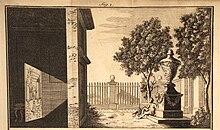

A camera obscura (pl. camerae obscurae or camera obscuras; from Latin camera obscūra 'dark chamber')[1] is the natural phenomenon in which the rays of light passing through a small hole into a dark space form an image where they strike a surface, resulting in an inverted (upside down) and reversed (left to right) projection of the view outside.[2][3][4]
Camera obscura can also refer to analogous constructions such as a darkened room, box or tent in which an exterior image is projected inside or onto a translucent screen viewed from outside. Camera obscuras with a lens in the opening have been used since the second half of the 16th century and became popular as aids for drawing and painting. The technology was developed further into the photographic camera in the first half of the 19th century, when camera obscura boxes were used to expose light-sensitive materials to the projected image.
The image (or the principle of its projection) of lensless camera obscuras is also referred to as a "pinhole image".[5][6]
The camera obscura was used to study eclipses without the risk of damaging the eyes by looking directly into the Sun. As a drawing aid, it allowed tracing the projected image to produce a highly accurate representation, and was especially appreciated as an easy way to achieve proper graphical perspective.
Before the term camera obscura was first used in 1604, other terms were used to refer to the devices: cubiculum obscurum, cubiculum tenebricosum, conclave obscurum, and locus obscurus.[7]
A camera obscura without a lens but with a very small hole is sometimes referred to as a "pinhole camera", although this more often refers to simple (homemade) lensless cameras where photographic film or photographic paper is used.
- ^ "Introduction to the Camera Obscura". National Science and Media Museum. 28 January 2011. Archived from the original on 11 November 2021. Retrieved 17 September 2019.
- ^ Stoffregen, Thomas A. (October 2013). "On the Physical Origins of Inverted Optic Images". Ecological Psychology. 25 (4): 369–382. doi:10.1080/10407413.2013.839896. ISSN 1040-7413.
- ^ "Vermeer and the Camera Obscura, Part One". www.essentialvermeer.com. Retrieved 15 August 2024.
- ^ "Camera Obscura". Science World. Retrieved 15 August 2024.
- ^ Horenstein, Henry (1989). The Photographer's Source: A Complete Catalogue. Simon & Schuster. ISBN 978-0-671-64591-5. Archived from the original on 10 November 2023. Retrieved 29 October 2023.
- ^ Waldman, Gary (1 January 2002). Introduction to Light: The Physics of Light, Vision, and Color. Courier Corporation. ISBN 978-0-486-42118-6. Archived from the original on 10 November 2023. Retrieved 29 October 2023.
- ^ Phelps Gage, Henry (1914). Optic projection, principles, installation, and use of the magic lantern, projection microscope, reflecting lantern, moving picture machine. Comstock Publishing Company.
obscurum cubiculum.